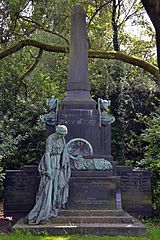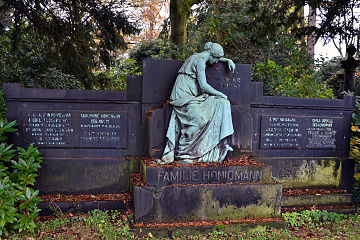Ostfriedhof Essen

Essen's communal Ostfriedhof is located near downtown Essen on the southeastern edge of the Südostviertel district . Among other things, it houses old graves of people from the city's history, most of whom were reburied from the abandoned cemetery at Kettwiger Tor .
History and character
The Ostfriedhof was created in 1893 within a residential area and therefore has an area of around 8.5 hectares, which is the same today, with space for around 1200 graves.
In 1910, its north-western main portal on Saarbrücker Straße was built according to a design by the Essen architect Edmund Körner , which was rebuilt in a simplified form after severe damage from the Second World War . It consists of two stone pillars around five meters high that support the iron gate. There are stone sculptures on the pillars, symbolizing grief on the one hand and hope on the other. Seen from the outside, behind and in the two columns, there is a room, one of which was previously used by the cemetery administration and the other housed a coffin wagon that was used to transport the coffin to the grave. From August 2017 to the end of 2017, the stone pillars were renovated and the two rooms were equipped with new doors and windows. The Foundation for the Beautification of the City of Essen took on the costs of around 20,000 euros . The foundation made a further 6,000 euros available in summer 2018. Both rooms have been renovated from the inside and are now used as storage rooms.
In addition to the main portal on Saarbrücker Straße, the Ostfriedhof has four other entrances: one on Saarbrücker Straße, one at the Elisabeth Hospital on Klara-Kopp- Weg and two in Herwarthstraße. The boundaries of the cemetery are Saarbrücker Straße in the north, Schinkelstraße in the west, Ruhrallee and Klara-Kopp-Weg in the south and Herwarthstraße in the east. With its old trees, the cemetery is considered a park within the city. The paths on the cemetery area are laid out at right angles. At the intersection of the two main paths there is a cross over several meters high. One main path leads from the main portal in the north-west to the south-east, the other from the cemetery chapel in the north-east to the south-west. The northeastern part of the cemetery offers large grave areas in contrast to the southwestern area with smaller row graves, which is criss-crossed by several small paths.
In 1955 around 150 graves were transferred from the abandoned cemetery at Kettwiger Tor to the east cemetery. The cemetery, which was laid out in 1827 as the first communal burial place outside the Essen city wall , in front of the Kettwig city gate, had to give way to the construction of the Ruhr Expressway, today's federal motorway 40 . The City of Essen wrote to all families about the imminent reburial and asked whether and how they consented to the reburial of the graves. In addition, the city had to ask the relatives for documents, because the city documents for the cemetery at Kettwiger Tor were all lost in the Second World War . Finally, all graves were moved, including some without their own grave, collected in a certain area of the grave field. The specially prepared grave fields 5 and 6 of the east cemetery, which, previously occupied by row graves, had been destroyed in the Second World War, housed a large part of the tombs. These were mostly loosely distributed on the meadow without their formerly existing enclosures. The aim was to restore the park-like character of the cemetery at Kettwiger Tor here. Few of these family graves are still managed with usage rights to this day. At an entrance to grave field 5, a stone slab was placed on which the lyrical choir of the dead by the Swiss poet Conrad Ferdinand Meyer is engraved. In addition to the people who were reburied and listed below, there is a memorial stone to the Catholic and Protestant clergy that was on both sides of the entrance gate of the cemetery at Kettwiger Tor.
On grave field 5 there is an area with the graves of Catholic clergymen who were reburied here, like the theologian Peter Beising , but who were also buried here more recently. On a stone pillar above the cemetery was a roughly life-size representation of the Good Shepherd, erected in 1961 and stolen by metal thieves in April 2013. Elsewhere in grave field 5 is the grave cross, newly erected in 1980 on the basis of old photographs, of the last senior court official of the Essen monastery , Clemens Alexander Freiherr von Asbeck.
On the edge of the East Cemetery, on the border to the Elisabeth Hospital , there is a grave field for unborn life and deceased infants of the hospital. Not far is the burial ground of the Order of the Sisters of St. Elisabeth . Due to the fact that the order has become small, and so that the care of the tomb can no longer be maintained by the order, a legacy grave was built in 2015 , a gravestone that has been redesigned as a grave of honor. Near Saarbrücker Straße there is a grave of the Franciscan monastery at the Holy Cross Church in the southeast quarter. Adjacent is one of the first private communal graves. It is that of the Catholic journeyman's association Essen-Ruhr, today's Kolping family .
On the north-eastern edge, today's cemetery chapel, which was completed in 1957 according to plans by the Essen architects Kölsch & Kölsch, replaces the old one that was destroyed in the Second World War. It was built in 1897 with an adjoining morgue based on plans by Edmund Körner, making it the first ensemble of buildings of its kind on an Essen cemetery.
Graves of personalities (selection)
Restored from the cemetery at Kettwiger Tor
- Gottschalk Diedrich Baedeker - founder of GD Baedeker Verlag , city grave of honor
- Diedrich Gottschalk Baedeker - from 1903 sole owner of GD Baedeker Verlag, city grave of honor
- Alfred Baedeker - bookseller, sole owner of GD Baedeker Verlag from 1922
- Julius Baedeker - publisher, bookseller and editor
- Peter Beising - Catholic theologian and honorary citizen of the city of Essen
- Richard Bömke - Kommerzienrat, member and chairman of the supervisory board of the Friedrich der Große colliery and the Essener Credit-Anstalt as well as Essen city councilor
- Otto Budde - member of the Krupp board of directors, head of the cannon department
- Carl Funke - industrialist, secret councilor, in a shared family crypt with the building contractor and city councilor Johann Wilhelm Schürenberg
- Friedrich Funke - industrialist, councilor of commerce
- Fritz Funke - building contractor, industrialist and city councilor
- Friedrich Grillo - large industrialist
- Gustav Hache - Lord Mayor of Essen, city grave of honor
- Heinrich Heintzmann - Secret Mountain Ridge, City Councilor and Director of the Society Association
- Ewald Hilger - mine director and secret mountain ridge
- The Ernst Honigmann family, grandson of the Markscheider and Mining Authority Director Johann Ehrenfried Honigmann , who designed the Honigmann's city map in 1803/1804 , the first topographical map of the city of Essen at that time
- Heinrich Arnold Huyssen - industrialist and mayor of the city of Essen
- Adolf Knaudt and Carl Julius Schulz - the two founders of the Schulz-Knaudt company
- Johann Conrad Kopstadt - Third Mayor of Essen from the Kopstadt family
- Edmund Lührmann - Essen patron, city grave of honor
- Albert Müller - banker, city councilor and secret councilor
- Wilhelm Nedelmann - businessman, city councilor, musician and composer, founder of the Essen Music Association, today's Philharmonic Choir Essen
- Felix Rauter - entrepreneur, city councilor, councilor of commerce
- Konrad Ribbeck - one of the first Essen city historians, city archivist
- Johann Wilhelm Schürenberg , building contractor, industrialist, city councilor
- Heinrich Carl Sölling - Essen patron and honorary citizen of the city of Essen, city grave of honor
- Theodor Wilhelm Varnhorst - Mayor from 1804 to 1808, city grave of honor
- Erich Zweigert - Lord Mayor of Essen, city grave of honor
Personalities buried here
- Johann Franz Heinrich Arens (1849–1920) - Essen local politician and historical researcher
- Gustav Beckmann - music director, founder of the Essen Bach Choir
- Ludwig von Born - banker, entrepreneur
- Wilhelm Busch - preacher and writer
- Fritz Funke - Chairman of the supervisory board of the Essen Actien beer brewery, which later became the Stern brewery
- Karl Friedrich (Artur) Koenig - Mayor from 1873 to 1906, city grave of honor
- Joseph Hoeren - Mayor of Stoppenberg
- Diether Krebs - actor
- Hans Piekenbrock - Lieutenant General in World War II
- Diether Posser - politician
- Maria Rust - founder
- Jacob Stauder - brewer, brought the private brewery Jacob Stauder to Altenessen in 1888
- Wilhelm Weigle - pastor and founder of the Protestant Weigle House , city grave of honor
- Mary Wigman - dancer and choreographer
- Friedrich Wolff - City Director (1957–1963), member of the Parliamentary Council
- Tombstones (selection)
Memorial stone to the buried clergy at the Kettwig Gate
Edmund Lührmann , patron, city grave of honor
Adolf Knaudt , company founder
Hans Piekenbrock , Lieutenant General, grave sculptures by Gustav Rutz (1911)
Richard Bömke , Councilor of Commerce, accessible crypt
Web links
Individual evidence
- ^ A b c Heike Schmidt: cemetery and grave monument in the industrial age using the example of Essen cemeteries: history - design - preservation; an art historical investigation with special consideration of the stone decay . Brockmeyer, Bochum 1993, ISBN 978-3-8196-0151-4 .
- ↑ The historical portal of the Ostfriedhof is being restored , in: Westdeutsche Allgemeine Zeitung of December 5, 2017; accessed on March 5, 2020
- ^ The portal of the Ostfriedhof can be further refurbished , in: Westdeutsche Allgemeine Zeitung of July 5, 2018; accessed on March 5, 2020
- ↑ a b c d e f g h i Historisches Portal Essen: Graves of honor of the city of Essen ; accessed on February 7, 2018
Coordinates: 51 ° 26 ′ 49 ″ N , 7 ° 1 ′ 52 ″ E










